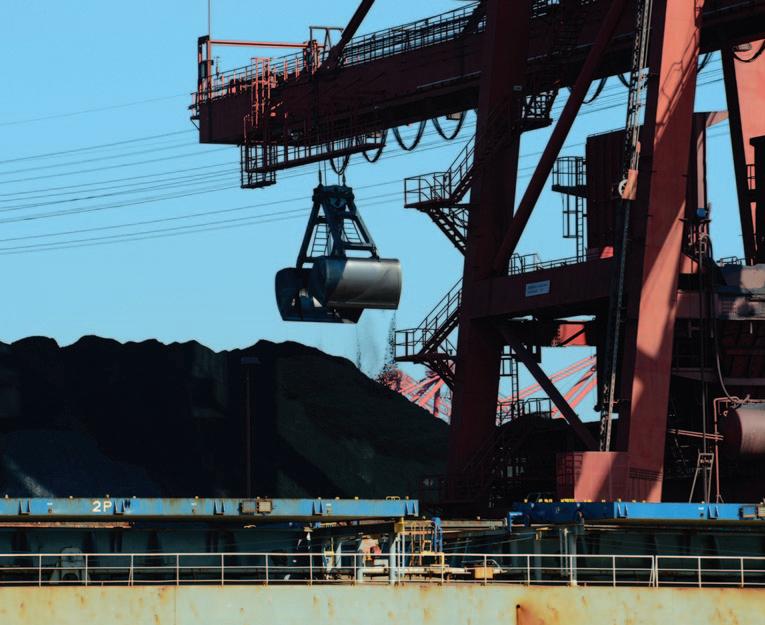
3 minute read
Port of Hamburg handles 58.2 million tonnes
Both the tense economic situation in Europe, especially in Germany, and background geopolitical factors continue to have repercussions on throughput in the Port of Hamburg. Despite these, Germany’s largest seaport can record a gain of 7.7% in bulk cargo throughput at 19mt (million tonnes). First-half general cargo throughput was 11.1% lower at 39.2mt. Terminal operators in the Port of Hamburg handled 58.2mt of seaborne cargoes were handled by terminal operators in the Port of Hamburg on the seaward side. This is a reduction of 5.8% less in comparisoned to the same period of the previous year. As one of the world’s largest rail ports, landward hinterland throughput is a significant aspect. With tonnage totalling 23.1mt, 2.1% lower, rail almost maintained transport volume there. “On a comparison with other North Sea ports in the North Range, it is absolutely clear that all players in this market are subject to the same tough prevailing circumstances,” stresses Axel Mattern, CEO of HHM – Port of Hamburg Marketing.
Bulk Cargo Totals Higher
The positive trend in bulk cargoes was attributable to all sectors. With 3.5mt handled, agribulk achieved a first-half increase of 18.6%. Up 18.1% and 5.3mt, the trend in throughput of liquid cargoes was similarly positive, while grab cargoes at 10.2mt were at almost the previous level.
SECOND - QUARTER RECOVERY IN CONTAINER HANDLING
Container handling in the Port of Hamburg improved in every month of the first half. In June, it was 10.2% higher than in January. Comparison of the first two quarters indicates a 4.6% rise in container throughput. As a rule, growth rates in this period are of around 0.6%. In total, 3.8 million TEU crossed the quay walls then, a fall of 11.7% in comparison with the same period of the previous year. Container throughput on a tonnage basis totalled 38.7mt, being 10.8% lower.
Positive Developments In North America And Asia
Traditionally, China heads the Top Ten list of trading partners and with 1.1 million TEU, the country retained first place in the first half year of 2023. Positive developments are evident in trade with further markets, for example in America. The USA continues to take second place among the Port of Hamburg’ trading partners, and was able to further consolidate this its position with a 7.4% increase, and throughput of 313,000 TEU. Canada advanced by 6.7% to 95,000 TEU. With 108,000 TEU, Central America achieved a 6.3% advance. It is on these routes that further growth is expected in the coming years as the Port of Hamburg develops as an energy hub. Over the next few years, it is especially on these routes that further growth can be expected in the wake of the Port of Hamburg’s expansion as an energy hub.
“Especially against a background of mounting uncertainty and global upheavals, we aim to establish close trading relations with a broad spectrum of partner countries. Increased dialogue with North and South America, along with India as a significant growth market, is a highly promising indicator in that context,” says Dr. Melanie Leonhard, Hamburg’s Senator of Economics.
Positive developments are also apparent in many parts of Asia. With a 9.3% rise in throughput on the same period of the previous year to 99,000 TEU, India achieved its best result for four years. Trade with Japan and Thailand has also increased. One of the Hamburg companies actively implementing this trend is packaging and digitalization specialist Deufol Group, also owner of the Wallmann Terminal. “The opportunities in foreign trade with North America and S.E. Asia are obvious to us. We are working with great commitment on expanding our intermeshed HUB solutions and infrastructures internationally, especially in North America and S.E. Asia. Our goal is to back up customers in running their project logistics more efficiently and sustainably,” says Dennis Hübner, CEO of Deufol, adding that “This positive trend is also reflected in the gratifying results on foreign trade with these regions. DEUFOL, including the Wallmann Terminal in Hamburg, is actively working on further promoting these developments, and on offering innovative and sustainable end-to-end solutions for global heavy-lift logistics.”
Prospects
“Persistent challenging economic and geopolitical circumstances do not allow firm predictions to be made on the development of throughput in the Port of Hamburg. We are assuming that at least the slightly positive trend of the second quarter will continue. How the year will develop further depends directly on the economic mood in Germany and geopolitical developments,” emphasizes Axel Mattern, CEO of Port of Hamburg Marketing.

